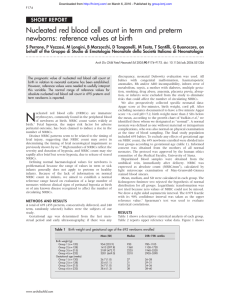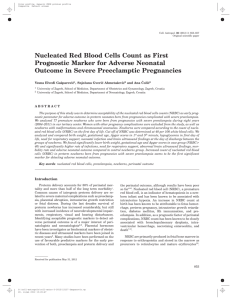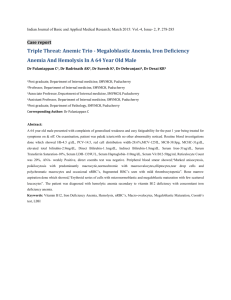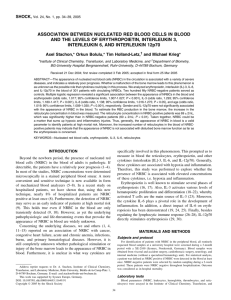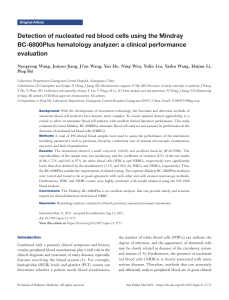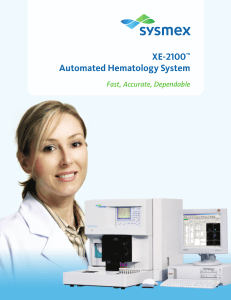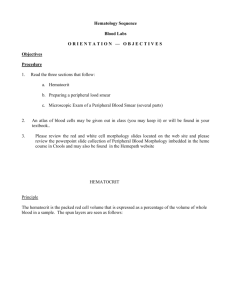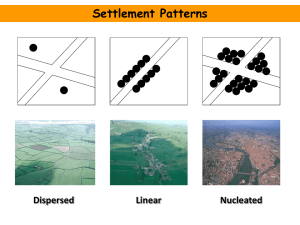The clinical relevance of measuring NRBC in the XN-CBC
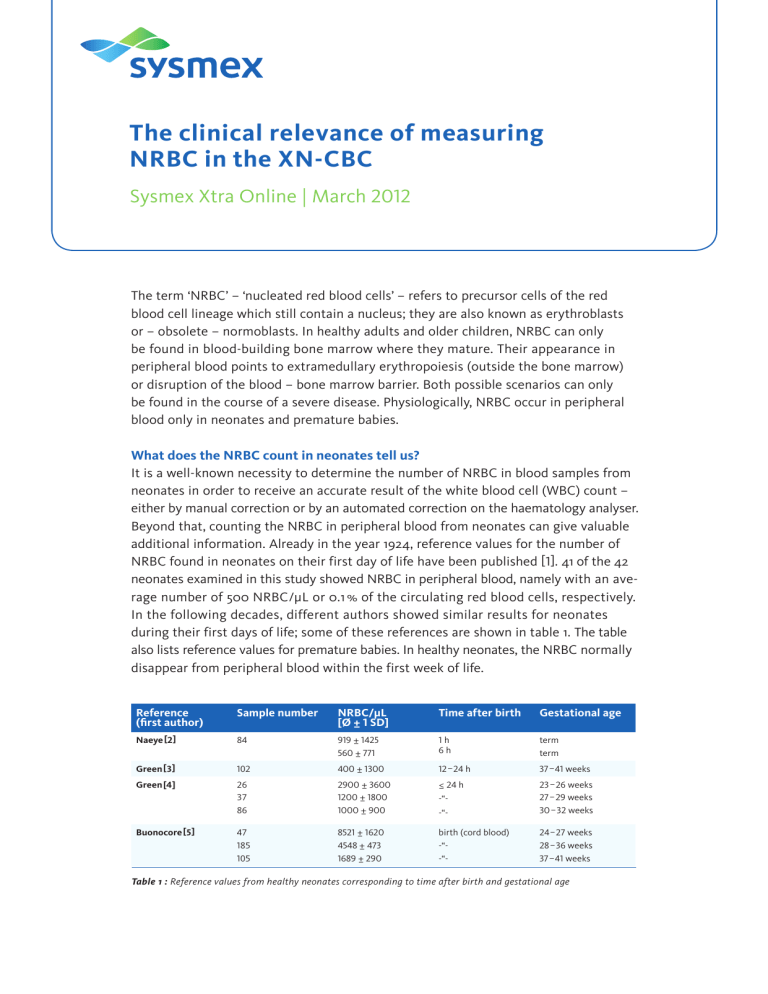
The clinical relevance of measuring
NRBC in the XN-CBC
Sysmex Xtra Online | March 2012
The term ‘NRBC’ – ‘nucleated red blood cells’ – refers to precursor cells of the red blood cell lineage which still contain a nucleus; they are also known as erythroblasts or – obsolete – normoblasts. In healthy adults and older children, NRBC can only be found in blood-building bone marrow where they mature. Their appearance in peripheral blood points to extramedullary erythropoiesis (outside the bone marrow) or disruption of the blood – bone marrow barrier. Both possible scenarios can only be found in the course of a severe disease. Physiologically, NRBC occur in peripheral blood only in neonates and premature babies.
What does the NRBC count in neonates tell us?
It is a well-known necessity to determine the number of NRBC in blood samples from neonates in order to receive an accurate result of the white blood cell (WBC) count – either by manual correction or by an automated correction on the haematology analyser.
Beyond that, counting the NRBC in peripheral blood from neonates can give valuable additional information. Already in the year 1924, reference values for the number of
NRBC found in neonates on their first day of life have been published [1]. 41 of the 42 neonates examined in this study showed NRBC in peripheral blood, namely with an average number of 500 NRBC/µL or 0.1 % of the circulating red blood cells, respectively.
In the following decades, different authors showed similar results for neonates during their first days of life; some of these references are shown in table 1. The table also lists reference values for premature babies. In healthy neonates, the NRBC normally disappear from peripheral blood within the first week of life.
Reference
(first author)
Naeye[2]
Green[3]
Green[4]
Buonocore[5]
102
26
37
86
Sample number NRBC/µL
[Ø ± 1 SD]
84 919 ± 1425
560 ± 771
400 ± 1300
2900 ± 3600
1200 ± 1800
1000 ± 900
47
185
105
8521 ± 1620
4548 ± 473
1689 ± 290
Time after birth
1 h
6 h
12–24 h
≤ 24 h
-“-
-“birth (cord blood)
-“-
-“-
Gestational age term term
37–41 weeks
23–26 weeks
27–29 weeks
30–32 weeks
24–27 weeks
28–36 weeks
37–41 weeks
Table 1 : Reference values from healthy neonates corresponding to time after birth and gestational age
Sysmex Xtra Online | March 2012 | 7 pages
The clinical relevance of measuring NRBC in the XN-CBC
Even in premature babies and neonates, knowing the exact number of NRBC allows drawing conclusions on their condition of health. Thus, NRBC counts greater than the indicated reference values may, for instance, refer to chronic or postnatal hypoxia, anaemia, maternal diabetes, or acute stress. Extremely increased values of up to 500
NRBC/100 WBC may even indicate an infectious disease such as congenital syphilis[6].
Although in 1–2% of the cases extremely increased NRBC concentrations might be idiopathic [7], they normally require rapid investigation of their cause in order to be able to start a potentially necessary treatment of the tiny patients as soon as possible.
Which relevance does the NRBC count have in older children and adults?
In adults and older children, the occurrence of NRBC in circulating blood always indicates a serious disease. NRBC may practically accompany almost every type of severe anaemia. Additionally, they are frequently seen in haemolytic anaemias, thalassaemias, haematological systemic diseases such as MDS or leukaemias, and severe bleeding, but they may also come along with a generally critical state of health
(e.g. trauma patients from intensive care units). The overview article ‘Nucleated RBCs –
Significance in the peripheral blood film’ by Constantino and Cogionis [8] gives a detailed listing of diseases associated with the occurrence of NRBC in peripheral blood and also explains the underlying mechanisms. As shown in the section Studies
on the clinical relevance of the NRBC count, the occurrence of NRBC in the peripheral blood of adults also correlates with an increased mortality. Since this increases – among other factors – with the number of NRBC found, it is useful to determine their exact number for better risk assessment. Moreover, the NRBC concentration can indicate to which extent the bone marrow is stressed or diseased.
Methods for NRBC counting
Manual count
In the manual differential blood count, without a preceding analyser flag, any existing
NRBC can be discovered only by chance. It is common practice in the microscopic examination to indicate the number of NRBC per 100 viewed WBC. Usually, 100–200
WBC (rarely up to 400 WBC) are viewed under the microscope. The problem of the manual count, however, lies in the fact that NRBC strongly resemble small lymphocytes; even experienced personnel can misclassify them as lymphocytes. This results in a falsely increased WBC number which may be particularly critical in leukopenic patients, for example during chemotherapy. Due to this fact and the high amount of work involved in the method, the manual count is unsuitable as a screening tool for
NRBC. If the laboratory uses a haematology analyser which is at least able to generate a flag for NRBC, manual counting can take place somewhat more targeted. Nevertheless, the manual NRBC count has to be considered as critical for statistical reasons alone, with an average coefficient of variation of 40 % (20–110 %) [9].
2
Sysmex Xtra Online | March 2012 | 7 pages
The clinical relevance of measuring NRBC in the XN-CBC
Flow cytometric count
There are different possibilities of determining NRBC with the help of antibody-mediated flow cytometry. All of these have in common that an antibody sensitive against surface characteristics of the cells (CD; ‘cluster of differentiation’) is needed. Usually, an antibody against CD71 is used, which is only expressed on red blood cells (RBC), both mature and immature. To make sure that mature non-nucleated RBC can be differentiated from immature nucleated RBC, nuclei and DNA, respectively, are stained in addition.
As an alternative, CD45, which is only expressed on white blood cells thus permitting a negative selection of the red blood cells, can be used instead of CD71. Although the flow cytometric method is quite accurate, its disadvantages prevail: by the employment of an antibody it is quite expensive, it is time-consuming, and it requires well-trained personnel, which makes it altogether not suitable for routine.
NRBC count on the Sysmex XN-Series
For more than 10 years, the counting of NRBC has been available on haematology analysers, but only with the introduction of the XN-Series it has become possible to determine NRBC routinely and accurately, without an increase in time, with each measurement. Since the NRBC count is included already in the complete blood count – the XN-CBC – waiting times for reflex tests and manual counts are eliminated and the potential errors of the latter avoided. Due to the auto-correction feature, WBC results are automatically corrected whenever necessary. Additionally, serious illnesses can be promptly recognised and therefore treated more rapidly and targeted. Patient monitoring is clearly facilitated under certain circumstances, which is particularly beneficial for patients e. g. from surgical wards where often merely a complete blood count is requested.
How does NRBC counting on the XN work? A special low-pH reagent stabilises the basophilic cells, which are counted in the same measuring channel, while all other WBC types are shrunk. The reagent lyses only the membrane of red blood cells and specifically labels the nucleus of any NRBC present. Interferences by lipids or lyse-resistant RBC are thus avoided. The exact mechanism is shown in fig. 1. Due to the resulting fluorescence and scattered light characteristics the cells can be separated as shown in fig. 2.
3
Sysmex Xtra Online | March 2012 | 7 pages
The clinical relevance of measuring NRBC in the XN-CBC
Lysis
Basophils
Lymphocytes
Monocytes
Granulocytes
(neutrophils, eosinophils)
Nucleated red blood cells
Red blood cells
Fig. 1: Labelling mechanism in the WNR channel
Labelling
Fluorescence Side scattered light
Strong Strong
Mittel
Medium
Mittel
Medium
Weak Medium
Very weak Very weak
With the haematology analysers of the
XN-Series, NRBC can be accurately counted in both low and high measurement ranges and results are given as absolute
(NRBC#) and relative values (NRBC%,/100
WBC) (fig. 3). Determining and displaying also the absolute count prevents e. g. the relative NRBC value to appear very low under the circumstances of a high absolute NRBC value and an extreme leukocytosis. The same applies for the reverse condition.
Fig. 2: WNR scattergram on the XN
4
Sysmex Xtra Online | March 2012 | 7 pages
The clinical relevance of measuring NRBC in the XN-CBC 5
Fig. 3: Main screen view of a normal measurement result
Studies on the clinical relevance of the NRBC count
The below mentioned studies from the years 2002–2011 have all been carried out on the XE-2100 analyser. Nevertheless, the resulting conclusions can be applied to the XN-Series.
n
Study of stem cell transplanted patients, performed at Jikei University Tokyo,
Japan, published in 2005 [10]: n
NRBC detection rates in the peripheral blood of 44 patients with different
malignant haematological diseases were compared, starting from one month
before stem cell transplantation until the time after engraftment of the transplant.
n
While directly after transplantation the detection rate and absolute NRBC
counts increased equally in both survivors and non-survivors, the detection rate
in the survivors group decreased after stem cell engraftment to 17 %. In contrast,
in the non-survivors group the detection rate increased even after stem cell
engraftment to 100 %.
n
Monitoring the NRBC count after stem cell transplantation could
therefore provide useful clinical information on the severity of the disease
and its progression.
Sysmex Xtra Online | March 2012 | 7 pages
The clinical relevance of measuring NRBC in the XN-CBC n
Study of thalassaemia patients, performed at two hospitals in Salerno
und Palermo, Italy, published in 2009 [11]: n
In this study, NRBC concentrations in the peripheral blood of 152 thalassaemia
patients were evaluated and compared with the results of 26 patients with
hereditary spherocytosis.
n
The number of NRBC reflected the ineffectiveness of the erythropoiesis:
the highest numbers were found in thalassaemia syndromes with almost
completely ineffective erythropoiesis whereas in patients with hereditary
spherocytosis (effective erythropoiesis) no NRBC were detected.
n
Therefore, the NRBC count could be useful to determine and assess the
ineffectiveness of erythropoiesis more exactly and potentially help to optimise
transfusion therapy in patients with severe thalassaemia syndromes.
n
Different studies of intensive care patients, performed at the Ruhr University
Bochum, Germany, published between 2002 and 2011 [12–15]: n
In one of the first studies of A. Stachon et al. [12] on this topic, NRBC values
of 4,173 patients from the university clinic Bochum [general and accident surgery,
heart surgery, neurology and internal medicine (without specialised haematology)]
were evaluated during a period of 12 weeks. It was noticeable that the highest
incidence of NRBC with 20 % was seen in patients from the general and accident
surgery and increased with age. Besides that, in this study population the
mortality of NRBC-positive patients was clearly increased with 21.1% in comparison
to NRBC-negative patients with 1.2%. Mortality increased with the number of
NRBC found and the duration of their occurrence.
n
In following studies[13–15] the evaluators were able to deepen their investigations
and confirm the results. It became apparent that the mortality of NRBC-positive
patients was always higher than that from NRBC-negative patients (approximately
10-fold, depending on the particular study population). Altogether, the mortality
of surgical intensive care patients with NRBC in their peripheral blood was the
highest found.
n
Monitoring the NRBC count after stem cell transplantation could therefore
provide useful clinical information on the severity of the disease and its
progression.
n
An NRBC screening could help to promptly identify patients at high risk since the
occurrence of NRBC in peripheral blood is a phenomenon appearing relatively
early prior to death. In addition to that, NRBC-positive patients should receive
longer intensive care treatment, because the mortality was clearly higher in patients
positive for NRBC on the day of transfer to a normal ward than in those negative
for NRBC on that day.
6
Sysmex Xtra Online | March 2012 | 7 pages
The clinical relevance of measuring NRBC in the XN-CBC
References
[1] Lippman HS. (1924): Morphologic and quantitative study of blood corpuscles in the newborn period.
Am J Dis Child 27 : 473–515.
[2] Naye RL, Localio AR. (1995): Determining the time before birth when ischemia and hypoxemia initiated cerebral palsy.
Obstet Gynecol 86 : 713 –19.
[3] Green DW. (1990): Mimoumi G. Nucleated erythrocytes in healthy infants and in infants of diabetic mothers.
J Pediatr 166 : 129–31.
[4] Green DW, Hendon B, Mimouni FB. (1995): Nucleated erythrocytes and intraventricular hemorrhage in preterm neonates. Pediatrics 96 : 475–8.
[5] Buonocore G, Perrone S, Gioia D, Gatti MG, Massafra C, Agosta R, Bracci R. (1999): Nucleated red blood cell count at birth as an indexof perinatal brain damage. Am J Obstet Gynecol 181 : 1500–5.
[7] Hanlon-Lundberg KM, Kirby RS, Gandhi S, Broekhuizen FF. (1997): Nucleated red blood cells in cord blood of singleton term neonates. Am J Obstet Gynecol 176 : 1149–56.
[8] Constantino BT, Cogionis B. (2000): Nucleated RBCs – Significance in the peripheral blood film. Lab Med 31 : 223–229.
[9] Tsuji T, Sakata T, Hamaguchi Y, Wang F, Houwen B. (1999): New rapid flow cytometric method for the enumeration of nucleated red bloods. Cytometry 37 : 291–301.
[10] Otsubo H, Kaito K, Asai O, Usui N, Kobayashi M, Hoshi Y. (2005): Persistent nucleated red blood cells in peripheral blood is a poor prognostic factor in patients undergoing stem cell transplantation. Clin Lab Haem 27 : 242–246.
[11] Danise P, Amendola G, Di Concilio R, Cillari E, Gioia M, Di Palma A, Avino D, Rigano P, Maggio A. (2009):
Nucleated red blood cells and soluble transferrin receptor in thalassemia syndromes: relationship with global and ineffective erythropoiesis. Clin Chem Lab Med 47 : 1539–42.
[12] Stachon A, Sondermann N, Imohl M, Krieg M.
(2002): Nucleated red blood cells indicate high risk of in-hospital mortality. J Lab Clin Med 140 : 407–12.
[13] Stachon A, Kempf R, Holland-Letz T, Friese J, Becker A, Krieg M. (2006): Daily monitoring of nucleated red blood cells in the blood of surgical intensive care patients. Clin Chim Acta 366 : 329 –335.
[14] Stachon A, Segbers E, Holland-Letz T, Kempf R, Hering S, Krieg M. (2007): Nucleated red blood cells in the blood of medical intensive care patients indicate increased mortality risk: a prospective cohort study. Critical Care 11 : R62.
[15] Kuert S, Holland-Letz T, Friese J, Stachon A.
(2011): Association of nucleated red blood cells in the blood and arterial oxygen partial tension. Clin Chem Lab Med 49 : 257 –263.
[16] Hermansen MC. (2001): Nucleated red blood cells in the fetus and newborn. Arch Dis Child Fetal Neonatal Ed 84: F211–F215.
7
Sysmex Europe GmbH
Bornbarch 1, 22848 Norderstedt, Germany, Phone +49 (40) 52726-0 · Fax +49 (40) 52726-100 · info@sysmex-europe.com · www.sysmex-europe.com
Please find your local Sysmex representative address under www.sysmex-europe.com
